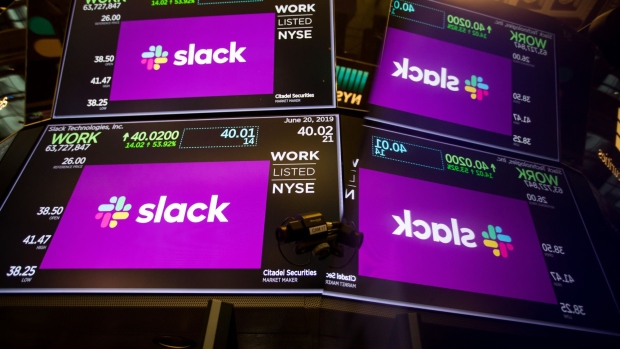Sep 4, 2019
Slack projects slowing pace for revenue over second half
, Bloomberg News

Slack Technologies Inc. (WORK:UN) shares plunged in extended trading after projecting slower sales growth for the second half of the year, a signal that strong competition may dent the software maker’s rapid rise.
Revenue will be US$154 million to US$156 million in the fiscal third quarter, reflecting a year-over-year increase of 46 per cent to 48 per cent, the San Francisco-based company said Wednesday in a statement. Analysts, on average, estimated US$154.2 million, according to data compiled by Bloomberg.
In the period ended July 31, sales jumped 58 per cent to US$145 million. Slack reported an adjusted loss of 14 cents a share for the quarter, compared with analysts’ estimates of 19 cents.
Slack reported results for the first time since completing a direct listing on the New York Stock Exchange in June that made the software maker a publicly traded company. While there is a free version of the company’s software, Chief Executive Officer Stewart Butterfield has sought to increase the number of large companies that pay to use the workplace communications product. Slack will have to maintain soaring growth to please investors while competing against the world’s largest software maker, Microsoft Corp., as well as Alphabet Inc. and Facebook Inc.
“The rate of growth as you get larger is going to go down,” Butterfield said in an interview. “But that’s still very strong growth. The thing that we do is focus on the value we’re creating for customers. It’s going to be a long transformation.”
Slack’s shares fell about 15 per cent in extended trading after the earnings release. The stock has climbed 20 per cent to US$31.07 since the company went public, though it also has dropped about 20 per cent from its closing high of US$38.62 on its first day of trading June 20.
The company reported its net loss widened to US$360 million, or 98 cents a share, from US$31.9 million, or 26 cents, in the period a year earlier.
Slack had been one of Silicon Valley’s most-talked about unicorns, raising about US$1.3 billion in total funding, and gaining a valuation of US$7.1 billion in a funding round in August 2018. The company has sought to emphasize that it’s more than just an office messaging platform where employees chat using memes, GIFs and emojis. The system connects to companies’ other applications in an effort to streamline corporate work flows.
The company raised its fiscal 2020 sales forecast to US$603 million to US$610 million, which would mean an annual growth rate of 51 per cent to 52 per cent. But the midpoint missed analysts’ average estimate of US$607.2 million.
For Slack, the key to growth is fueling demand among large businesses. Less than 1 per cent of Slack’s customer base was made up of large customers that spend more than US$100,000 a year, according to Bloomberg Intelligence analyst Andrew Eisenson.
The company’s success adding large customers also slowed in the quarter. The number of those customers grew 75 per cent to 720 compared with a year earlier, but that’s slower than the pace of the fiscal first quarter. It’s also dwarfed by Slack’s 97 per cent growth in this metric a year ago.
While Slack’s paid customer base increased 5,000 in the quarter to 100,000, the pace of growth has slowed down -- to a 37 per cent year-over-year increase from 55 per cent a year earlier.
Bloomberg Beta, the venture capital arm of Bloomberg LP, is an investor in Slack.





